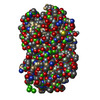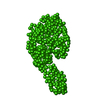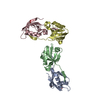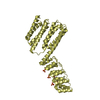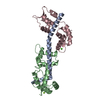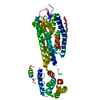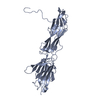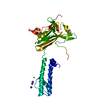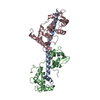[English] 日本語
 Yorodumi
Yorodumi- SASDDE9: Synechocystis fluorescence recovery protein FRPcc in the pre-oxid... -
+ Open data
Open data
- Basic information
Basic information
| Entry | Database: SASBDB / ID: SASDDE9 |
|---|---|
 Sample Sample | Synechocystis fluorescence recovery protein FRPcc in the pre-oxidized state (CC mutant)
|
| Function / homology | Fluorescence recovery protein / : / Photoprotection regulator fluorescence recovery protein / plasma membrane-derived thylakoid membrane / Fluorescence recovery protein Function and homology information Function and homology information |
| Biological species |  |
 Citation Citation |  Journal: Nat Commun / Year: 2018 Journal: Nat Commun / Year: 2018Title: OCP-FRP protein complex topologies suggest a mechanism for controlling high light tolerance in cyanobacteria. Authors: Nikolai N Sluchanko / Yury B Slonimskiy / Evgeny A Shirshin / Marcus Moldenhauer / Thomas Friedrich / Eugene G Maksimov /   Abstract: In cyanobacteria, high light photoactivates the orange carotenoid protein (OCP) that binds to antennae complexes, dissipating energy and preventing the destruction of the photosynthetic apparatus. At ...In cyanobacteria, high light photoactivates the orange carotenoid protein (OCP) that binds to antennae complexes, dissipating energy and preventing the destruction of the photosynthetic apparatus. At low light, OCP is efficiently deactivated by a poorly understood action of the dimeric fluorescence recovery protein (FRP). Here, we engineer FRP variants with defined oligomeric states and scrutinize their functional interaction with OCP. Complemented by disulfide trapping and chemical crosslinking, structural analysis in solution reveals the topology of metastable complexes of OCP and the FRP scaffold with different stoichiometries. Unable to tightly bind monomeric FRP, photoactivated OCP recruits dimeric FRP, which subsequently monomerizes giving 1:1 complexes. This could be facilitated by a transient OCP-2FRP-OCP complex formed via the two FRP head domains, significantly improving FRP efficiency at elevated OCP levels. By identifying key molecular interfaces, our findings may inspire the design of optically triggered systems transducing light signals into protein-protein interactions. |
 Contact author Contact author |
|
- Structure visualization
Structure visualization
| Structure viewer | Molecule:  Molmil Molmil Jmol/JSmol Jmol/JSmol |
|---|
- Downloads & links
Downloads & links
-Models
| Model #2147 |  Type: mix / Radius of dummy atoms: 1.90 A / Chi-square value: 1.06 / P-value: 0.063614  Search similar-shape structures of this assembly by Omokage search (details) Search similar-shape structures of this assembly by Omokage search (details) |
|---|
- Sample
Sample
 Sample Sample | Name: Synechocystis fluorescence recovery protein FRPcc in the pre-oxidized state (CC mutant) Specimen concentration: 1.7 mg/ml |
|---|---|
| Buffer | Name: 20 mM Tris 150 mM NaCl 3% glycerol / pH: 7.6 |
| Entity #1175 | Type: protein / Description: Fluorescence recovery protein / Formula weight: 14.09 / Num. of mol.: 2 / Source: Synechocystis sp. (strain PCC 6803 / Kazusa) / References: UniProt: P74103 Sequence: MRGSHHHHHH TDPATMLQTA EAPWSQAETQ SAHALFRKAY QRELDGLCAT VQAQASQCTQ IDDLWKLHDF LSAKRHEIDG KYDDRQSVII FVFAQLLKEG LVQAEELTFL AADKQSKIKA LARL |
-Experimental information
| Beam | Instrument name: PETRA III EMBL P12 / City: Hamburg / 国: Germany  / Type of source: X-ray synchrotron / Wavelength: 0.124 Å / Type of source: X-ray synchrotron / Wavelength: 0.124 Å | |||||||||||||||||||||||||||||||||
|---|---|---|---|---|---|---|---|---|---|---|---|---|---|---|---|---|---|---|---|---|---|---|---|---|---|---|---|---|---|---|---|---|---|---|
| Detector | Name: Pilatus 2M | |||||||||||||||||||||||||||||||||
| Scan | Measurement date: Sep 1, 2017 / Storage temperature: 20 °C / Cell temperature: 10 °C / Exposure time: 0.05 sec. / Number of frames: 20 / Unit: 1/nm /
| |||||||||||||||||||||||||||||||||
| Distance distribution function P(R) |
| |||||||||||||||||||||||||||||||||
| Result |
|
 Movie
Movie Controller
Controller

 SASDDE9
SASDDE9